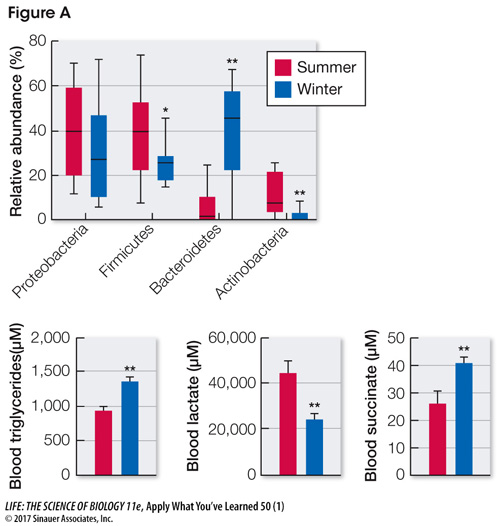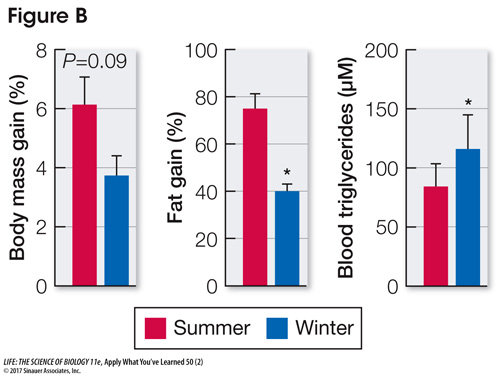Apply What You’ve Learned
Review
50.1
Fats, carbohydrates, and proteins in food provide energy.
50.2
Heterotrophs display a wide diversity of adaptations for acquiring and processing food.
50.2
Heterotrophs rely on symbiotic bacteria residing in their digestive systems to carry out essential tasks in digestion.
Original Paper: Sommer, F. et al. 2016. The gut microbiota modulates energy metabolism in the hibernating brown bear Ursus arctos. Cell Reports 14: 1655−1661.
Winter in the Northern Hemisphere can be a harsh period of low temperatures, deep snow cover, and limited food. The brown bear (Ursus arctos) survives the winter by hibernating. Bears do not eat during hibernation; but prior to the onset of winter, they overeat—
In recent years, information has been accumulating about the importance of the gut microbiota in the digestion of food and in many other aspects of nutrition. Researchers asked whether the gut microbiome of the bear was different when the bear was fattening and when it was fasting. They studied blood and fecal samples from 16 free-

The observed seasonal differences in the microbiota could result simply from the presence or absence of food in the gut. To test whether summer and winter microbiota could have different influences on nutritional status, the researchers examined the effects of these microbiota when introduced into germ-

Questions
1.
How do the data on seasonal changes in blood triglycerides, lactate, and succinate indicate changes in the bears’ metabolism between summer and winter? (Keep in mind that lactate is a product of glycolysis, and succinate is a citric acid cycle intermediate.)
The higher triglyceride levels in winter indicate a greater dependence on fat metabolism during winter, and this is supported by the decrease in winter of lactate, a product of glycolysis (carbohydrate metabolism), and the increase in succinate, which is a citric acid cycle intermediate. Since both carbohydrate and triglyceride metabolites enter the citric acid cycle as acetyl CoA, these data support the idea of an increase in dependence on fat metabolism during winter.
2.
Do the data indicate significant seasonal changes in the gut microbiome of the bears? Propose hypotheses that would help explain any changes.
The data show significant changes in three highly abundant phyla and no change in one highly abundant phylum. Thus we can conclude that there are major seasonal changes in the gut microbiome. These changes could be due simply to the presence or absence of food in the gut over a substantial period of time, or the changes could play a role in the different metabolic states of the bears in summer and winter.
3.
What do the data indicate about how the energy balance of the germ-
The data indicate that the summer microbiota promote greater mass and fat gain than winter microbiota. Two hypotheses that could explain this difference are that (1) some signal from the summer microbiota stimulates greater food intake, and (2) the summer microbiota is more efficient at facilitating digestion when there is high nutrient flow through the gut.
4.
Taken together, what do all of these data suggest about digestive adaptations of brown bears that aid their survival in their native habitat?
The data suggest that a seasonal change in the gut microbiome of the bears supports and may promote increased food intake and digestive efficiency in the summer months. The change from the summer to the winter gut microbiome may result from some microbial species being able to survive a long duration of fasting, or the change in microbiome may have a functional significance in altering energy metabolism to promote storage in the summer and conservation in the winter.
Go to LaunchPad for the eBook, LearningCurve, animations, activities, flashcards, and additional resources and assignments.